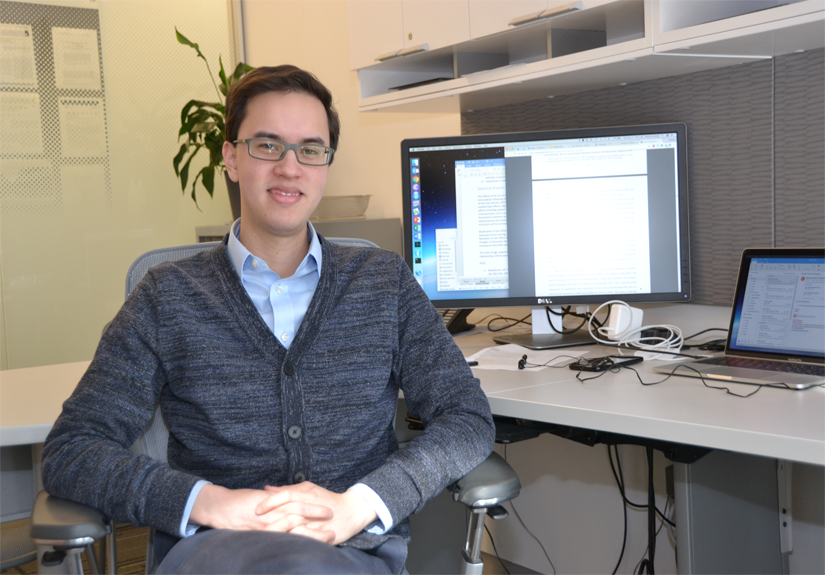Get to Know: Patrick Schnell
Ohio State Public Health sits down with Patrick Schnell, PhD, assistant professor of biostatistics, who joined the college’s faculty ranks this academic year.
By Janaya Greene

You’re a Buckeye alum who pursued your doctorate at the University of Minnesota. What brought you back to Ohio State?
I grew up in this midwestern, urban culture, and both my family and my wife’s family live in Cincinnati. When I decided to keep doing biostatistics in academia, we began looking at places that have a similar culture and would allow us to easily get back to see our families on a regular basis. Out of our options, Ohio State’s biostatistics department was the best fit.
What about the department stood out to you compared to other universities?
One thing is how the biostatistics department is integrated with the rest of the college. At many universities, biostatistics is the odd one out—often not even in the same location. That’s something that affects both students, who aren’t seeing or working with other areas of public health, and faculty, because it’s harder to be in close collaboration with other public health researchers if you’re not seeing them often.
What research are you currently working on?
My research is statistical methods for clinical trials; that involves both the design of trials and analysis of the data you get out of the trials. One thing I specifically focus on within clinical trials are identifying which types of patients benefit from a particular treatment. It’s with the hopes that if you have more information about who in particular is benefiting, then you can make better choices for the patient and make more efficient programs for allocating treatments to specific patients rather than automatically giving everybody the same thing.
I also monitor the safety of ongoing trials, making sure people who are given a treatment aren’t experiencing high adverse events that are outside of what is considered an acceptable range for that type of treatment.
That same feeling of discoverythat I experience vicariously through literature and movies is the same feeling of discovery I really enjoy in my work.—Patrick Schnell, PhD
What role does the Division of Biostatistics at CPH play in advancing these discoveries?
Methodologically, there are plenty of people around the division who are experts in things that I’m not. Whenever I’m working with areas of specialty that other people have more familiarity with, it’s really useful to get their input. Another thing this division helps me with more often is collaborative research. Sometimes my colleagues will refer a project to me if it falls under my particular specialty. These referrals have pretty quickly set up a good number of collaborative relationships that are useful in working on both the collaborative science and my methods research.
What do you do for fun?
I really like bicycling. I don’t race but I make it a point to commute by bike and go for casual rides when the weather is good enough. I also enjoy certain types of computer games, particularly simulation games that are a version of what we care about in public health. Games where you can build a city or a transit system I find fun because you can play around with ideas you care about with low-stakes and on a reasonable time scale.
Would you say your passion for public health drives your love of simulation games?
I don’t know what causes what, but there’s some type of connection there. My early attraction to computer games got me into computer programming and mathematics. That ended up having a big impact on the math and computer science I’m interested in.
You’re a big science fiction fan. What’s your favorite science-fiction work?
My favorite movie is “2001: A Space Odyssey,” directed by Stanley Kubrick. It’s such a beautifully shot film. My favorite thing about science fiction is that realization that you really don't know what’s going on in the broader universe; it’s just this huge mystery. You end up with the same feeling when doing mathematical research, where part of the joy in it is that you really have no idea what’s going on and it’s OK. That same feeling of discoverythat I experience vicariously through literature and movies is the same feeling of discovery I really enjoy in my work.
Published in Ohio State Public Health's Spring/Summer 2018 edition.
About The Ohio State University College of Public Health
The Ohio State University College of Public Health is a leader in educating students, creating new knowledge through research, and improving the livelihoods and well-being of people in Ohio and beyond. The College's divisions include biostatistics, environmental health sciences, epidemiology, health behavior and health promotion, and health services management and policy. It is ranked 22nd among all colleges and programs of public health in the nation, and first in Ohio, by U.S. News and World Report. Its specialty programs are also considered among the best in the country. The MHA program is ranked 5th and the health policy and management specialty is ranked 21st.